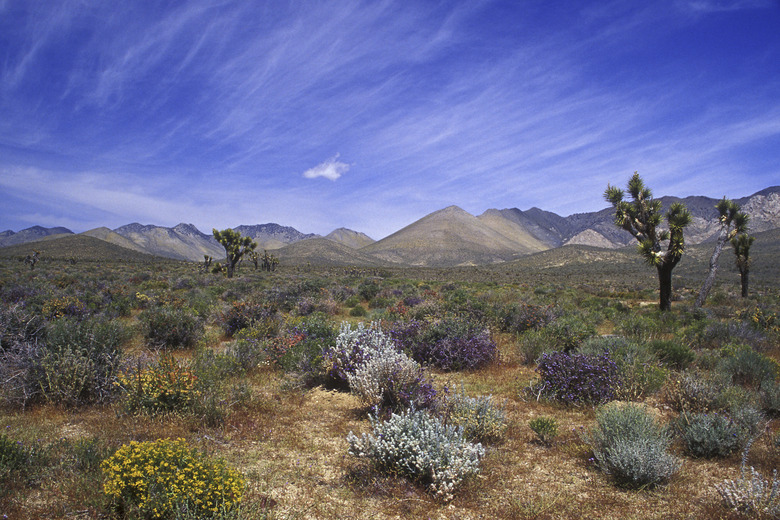Soil Characteristics Of Deserts
Gardening in desert soils presents challenges for even the most tenacious gardeners, especially if you've come from non-desert regions where soil runs deep and black. In many desert soils, garden spades that slide easily into Midwest gardens get traded in for a chisel and pickax. The secret to success with desert-soil gardening is learning to work with what you have. Recognizing characteristics common to many desert soils helps you turn those challenges around.
Water, Weathering and Desert Drainage
Water, Weathering and Desert Drainage
Deserts and their soils vary significantly, but most North American deserts have coarse-textured sand and gravel soil. Low desert rainfall limits the intense weathering that creates deep soils in non-arid regions. Rather than breaking down into smaller pieces, desert soils stay in large particles. Finer soil particles blow away. Most desert soils drain quickly and have no subsurface water, but desert gardeners soon discover water only drains well to a point. The depth of fast-draining soil depends on what's beneath. Check drainage before you plant in desert soil. Dig a hole, fill it with water, and check back in four hours. If the water level dropped 4 inches, drainage should be adequate for most garden plants.
Minerals, Nutrients and Organic Matter
Minerals, Nutrients and Organic Matter
In contrast to dark soils seen in non-arid regions, light-colored desert soils are mineral soils with little organic matter. With sparse vegetation, few microorganisms exist. In non-desert regions, water fuels decomposition from plentiful vegetation. This supports soil microorganisms and nutrient creation, which support more vegetation. Desert soils lack plentiful water to support rich organic activity. Despite this, they often have abundant nutrients; they just need water to put them in soluble forms plants can absorb. Biological activity in desert soils stays at surface level, where lichens and other creatures form a protective shield. Don't incorporate organic matter into desert soil; it can make garden conditions worse. Instead, apply liberal organic mulches on the surface, where the action is.
Alkalinity, Salinity and pH Adjustment
Alkalinity, Salinity and pH Adjustment
Ideal garden soil pH for most plants is a near-neutral, slightly acidic range from 6.0 to 7.0. When pH swings high or low, some nutrients get tied up and other elements reach toxic levels. Most desert soils are alkaline, due to accumulations that never see enough rainwater to wash away. Many desert gardens have soil pH of 8.0 or higher. Iron, manganese and other elements are kept from plants at these levels. Desert soils often experience high salinity, too. Irrigation salts build up and never leach away. Root-zone salts draw water away from plant roots and intensify drought. Amendments used to offset alkalinity in non-desert regions don't work in saline soil. Bypass this never-ending battle with desert-adapted, alkaline-loving plants that thrive on limited irrigation.
Hardpan, Caliche and Desert Pavement
Hardpan, Caliche and Desert Pavement
Things stay put in desert soils that rain would sweep away. Rainfall rates determine where hardpan layers formed. Several feet down or on the surface, with thicknesses from inches to many feet, hardpan limits planting depths. High-pH calcium carbonate, known as caliche or desert cement, restricts roots, water and nutrients. Poor drainage and poorly anchored plants result. Another challenge comes when winds steal all but pebbles, quartz and stones, creating a natural mosaic called desert pavement. Dig desert planting holes three to five times as wide as plant containers. With shallow hardpan, add depth with additional native soil on top. Break holes through hardpan, when possible, so irrigation and roots find their way out.
References
- The University of Arizona Cooperative Extension: Soils and Fertilizers: Soils
- Indiana Public Media: A Moment of Science: The Dirt About Desert Soil
- Soil Science Society of America: K-12 Soil Science Teacher Resources: Desert Soils
- University of California Museum of Paleontology: The Desert Biome
- The University of Arizona Cooperative Extension: Managing Caliche in the Home Yard
Cite This Article
MLA
Hansen, Jolene. "Soil Characteristics Of Deserts" sciencing.com, https://www.sciencing.com/soil-characteristics-of-deserts-12400546/. 22 October 2010.
APA
Hansen, Jolene. (2010, October 22). Soil Characteristics Of Deserts. sciencing.com. Retrieved from https://www.sciencing.com/soil-characteristics-of-deserts-12400546/
Chicago
Hansen, Jolene. Soil Characteristics Of Deserts last modified March 24, 2022. https://www.sciencing.com/soil-characteristics-of-deserts-12400546/
